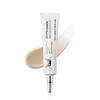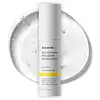What's inside
What's inside
 Key Ingredients
Key Ingredients

 Benefits
Benefits

 Concerns
Concerns

No concerns
 Ingredients Side-by-side
Ingredients Side-by-side

Water
Skin ConditioningMagnesium Aluminum Silicate
Absorbent1,2-Hexanediol
Skin ConditioningNiacinamide
SmoothingSodium Silicate
BufferingCitric Acid
BufferingXanthan Gum
EmulsifyingEthylhexylglycerin
Skin ConditioningAdenosine
Skin ConditioningDextrin
AbsorbentTheobroma Cacao Extract
Skin ConditioningArbutin
AntioxidantGlutathione
Hydrolyzed Sponge
Skin ConditioningGlycerin
HumectantCaprylic/Capric Triglyceride
MaskingButylene Glycol
HumectantBakuchiol
AntimicrobialAdansonia Digitata Seed Oil
EmollientHydrogenated Lecithin
EmulsifyingDimethyl Isosorbide
SolventCeramide NP
Skin ConditioningChondrus Crispus Extract
Skin ConditioningHydrolyzed Elastin
EmollientSaccharum Officinarum Extract
MoisturisingTocopherol
AntioxidantHydrolyzed Collagen
EmollientCeramide As
Skin ConditioningCeramide Ns
Skin ConditioningCeramide AP
Skin ConditioningCeramide Eos
Skin ConditioningSodium Hyaluronate
HumectantWater, Magnesium Aluminum Silicate, 1,2-Hexanediol, Niacinamide, Sodium Silicate, Citric Acid, Xanthan Gum, Ethylhexylglycerin, Adenosine, Dextrin, Theobroma Cacao Extract, Arbutin, Glutathione, Hydrolyzed Sponge, Glycerin, Caprylic/Capric Triglyceride, Butylene Glycol, Bakuchiol, Adansonia Digitata Seed Oil, Hydrogenated Lecithin, Dimethyl Isosorbide, Ceramide NP, Chondrus Crispus Extract, Hydrolyzed Elastin, Saccharum Officinarum Extract, Tocopherol, Hydrolyzed Collagen, Ceramide As, Ceramide Ns, Ceramide AP, Ceramide Eos, Sodium Hyaluronate
Water
Skin ConditioningGlycerin
HumectantCaprylic/Capric Triglyceride
MaskingPolyglycerin-3
HumectantButylene Glycol
Humectant1,2-Hexanediol
Skin ConditioningNiacinamide
SmoothingMethylpropanediol
SolventDiglycerin
HumectantLaminaria Japonica Extract
Skin ProtectingEclipta Prostrata Leaf Extract
Skin ConditioningHydrogenated Lecithin
EmulsifyingAmmonium Acryloyldimethyltaurate/Vp Copolymer
Dipropylene Glycol
HumectantAcrylates/C10-30 Alkyl Acrylate Crosspolymer
Emulsion StabilisingGlutathione
Tromethamine
BufferingEthylhexylglycerin
Skin ConditioningHydrolyzed Sponge
Skin ConditioningFructooligosaccharides
HumectantAdenosine
Skin ConditioningBeta-Glucan
Skin ConditioningGlyceryl Polymethacrylate
Hydrolyzed Hyaluronic Acid
HumectantCalcium Silicate
AbsorbentSodium Silicate
BufferingTocopherol
Antioxidant3-O-Ethyl Ascorbic Acid
Skin ConditioningTocopheryl Acetate
AntioxidantWater, Glycerin, Caprylic/Capric Triglyceride, Polyglycerin-3, Butylene Glycol, 1,2-Hexanediol, Niacinamide, Methylpropanediol, Diglycerin, Laminaria Japonica Extract, Eclipta Prostrata Leaf Extract, Hydrogenated Lecithin, Ammonium Acryloyldimethyltaurate/Vp Copolymer, Dipropylene Glycol, Acrylates/C10-30 Alkyl Acrylate Crosspolymer, Glutathione, Tromethamine, Ethylhexylglycerin, Hydrolyzed Sponge, Fructooligosaccharides, Adenosine, Beta-Glucan, Glyceryl Polymethacrylate, Hydrolyzed Hyaluronic Acid, Calcium Silicate, Sodium Silicate, Tocopherol, 3-O-Ethyl Ascorbic Acid, Tocopheryl Acetate
Ingredients Explained
These ingredients are found in both products.
Ingredients higher up in an ingredient list are typically present in a larger amount.
1,2-Hexanediol is a synthetic liquid and another multi-functional powerhouse.
It is a:
- Humectant, drawing moisture into the skin
- Emollient, helping to soften skin
- Solvent, dispersing and stabilizing formulas
- Preservative booster, enhancing the antimicrobial activity of other preservatives
Adenosine is in every living organism. It is one of four components in nucleic acids that helps store our DNA.
Adenosine has many benefits when used. These benefits include hydrating the skin, smoothing skin, and reducing wrinkles. Once applied, adenosine increases collagen production. It also helps with improving firmness and tissue repair.
Studies have found adenosine may also help with wound healing.
In skincare products, Adenosine is usually derived from yeast.
Learn more about AdenosineButylene Glycol (or BG) is used within cosmetic products for a few different reasons:
Overall, Butylene Glycol is a safe and well-rounded ingredient that works well with other ingredients.
Though this ingredient works well with most skin types, some people with sensitive skin may experience a reaction such as allergic rashes, closed comedones, or itchiness.
Learn more about Butylene GlycolThis ingredient is an emollient, solvent, and texture enhancer. It is considered a skin-softener by helping the skin prevent moisture loss.
It helps thicken a product's formula and makes it easier to spread by dissolving clumping compounds.
Caprylic Triglyceride is made by combining glycerin with coconut oil, forming a clear liquid.
While there is an assumption Caprylic Triglyceride can clog pores due to it being derived from coconut oil, there is no research supporting this.
Learn more about Caprylic/Capric TriglycerideEthylhexylglycerin (we can't pronounce this either) is commonly used as a preservative and skin softener. It is derived from glyceryl.
You might see Ethylhexylglycerin often paired with other preservatives such as phenoxyethanol. Ethylhexylglycerin has been found to increase the effectiveness of these other preservatives.
Glutathione is an antioxidant naturally found in our bodies. It is made up of three amino acids: glycine, cysteine, and glutamic acid.
As an antioxidant, it prevents oxidative damage to parts of our cell.
While glutathione is said to help with fading dark spots, the results from research are inconclusive. Further studies are needed. With that said, gluthatione has been shown to protect our skin from UV-B induced damage.
This ingredient is naturally occurring in plants, animals, fungi, and some bacteria.
Learn more about GlutathioneGlycerin is already naturally found in your skin. It helps moisturize and protect your skin.
A study from 2016 found glycerin to be more effective as a humectant than AHAs and hyaluronic acid.
As a humectant, it helps the skin stay hydrated by pulling moisture to your skin. The low molecular weight of glycerin allows it to pull moisture into the deeper layers of your skin.
Hydrated skin improves your skin barrier; Your skin barrier helps protect against irritants and bacteria.
Glycerin has also been found to have antimicrobial and antiviral properties. Due to these properties, glycerin is often used in wound and burn treatments.
In cosmetics, glycerin is usually derived from plants such as soybean or palm. However, it can also be sourced from animals, such as tallow or animal fat.
This ingredient is organic, colorless, odorless, and non-toxic.
Glycerin is the name for this ingredient in American English. British English uses Glycerol/Glycerine.
Learn more about GlycerinHydrogenated Lecithin is created from the hydrogenation of lecithin (a group of phospholipids). Hydrogenation is a chemical reaction between hydrogen and another element.
This ingredient is an emollient and emulsifier. As an emollient, it helps soften skin by trapping moisture within. As an emulsifier, it prevents oil and water ingredients from separating.
Hydrolyzed sponge comes from marine or freshwater sponges. This is the main ingredient for "spicules".
In some products, tiny microneedles called spicules are made from silica or hydrolyzed sponge. They help push active ingredients into the skin to enhance the penetration and efficacy of these ingredients.
Niacinamide is a multitasking form of vitamin B3 that strengthens the skin barrier, reduces pores and dark spots, regulates oil, and improves signs of aging.
And the best part? It's gentle and well-tolerated by most skin types, including sensitive and reactive skin.
You might have heard of "niacin flush", or the reddening of skin that causes itchiness. Niacinamide has not been found to cause this.
In very rare cases, some individuals may not be able to tolerate niacinamide at all or experience an allergic reaction to it.
If you are experiencing flaking, irritation, and dryness with this ingredient, be sure to double check all your products as this ingredient can be found in all categories of skincare.
When incorporating niacinamide into your routine, look out for concentration amounts. Typically, 5% niacinamide provides benefits such as fading dark spots. However, if you have sensitive skin, it is better to begin with a smaller concentration.
When you apply niacinamide to your skin, your body converts it into nicotinamide adenine dinucleotide (NAD). NAD is an essential coenzyme that is already found in your cells as "fuel" and powers countless biological processes.
In your skin, NAD helps repair cell damage, produce new healthy cells, support collagen production, strengthen the skin barrier, and fight environmental stressors (like UV and pollution).
Our natural NAD levels start to decline with age, leading to slower skin repair, visible aging, and a weaker skin barrier. By providing your skin niacinamide, you're recharging your skin's NAD levels. This leads to stronger, healthier, and younger looking skin.
Another name for vitamin B3 is nicotinamide. This vitamin is water-soluble and our bodies don't store it. We obtain Vitamin B3 from either food or skincare. Meat, fish, wheat, yeast, and leafy greens contain vitamin B3.
The type of niacinamide used in skincare is synthetically created.
Learn more about NiacinamideWe don't have a description for Sodium Silicate yet.
Tocopherol (also known as Vitamin E) is a common antioxidant used to help protect the skin from free-radicals and strengthen the skin barrier. It's also fat soluble - this means our skin is great at absorbing it.
Vitamin E also helps keep your natural skin lipids healthy. Your lipid skin barrier naturally consists of lipids, ceramides, and fatty acids. Vitamin E offers extra protection for your skin’s lipid barrier, keeping your skin healthy and nourished.
Another benefit is a bit of UV protection. Vitamin E helps reduce the damage caused by UVB rays. (It should not replace your sunscreen). Combining it with Vitamin C can decrease sunburned cells and hyperpigmentation after UV exposure.
You might have noticed Vitamin E + C often paired together. This is because it is great at stabilizing Vitamin C. Using the two together helps increase the effectiveness of both ingredients.
There are often claims that Vitamin E can reduce/prevent scarring, but these claims haven't been confirmed by scientific research.
Learn more about TocopherolWater. It's the most common cosmetic ingredient of all. You'll usually see it at the top of ingredient lists, meaning that it makes up the largest part of the product.
So why is it so popular? Water most often acts as a solvent - this means that it helps dissolve other ingredients into the formulation.
You'll also recognize water as that liquid we all need to stay alive. If you see this, drink a glass of water. Stay hydrated!
Learn more about Water